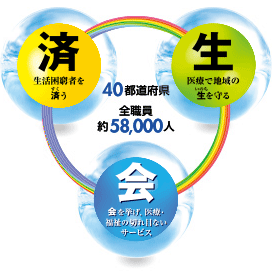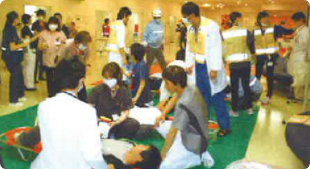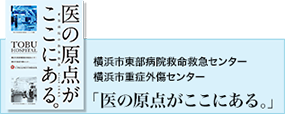

当院は、横浜市の総合計画「よこはま21世紀プラン」において、東部地域に急性期医療を⽀える中核病院を整備することが求められ、平成19年に設⽴された病院です。総合病院として地域の皆さまに最先端の医療を提供できるよう、常に「⼀歩先の医療」を目指しております。 当院が⾼度急性期医療を担う救命救急センターとしての役割を果たすためには、救急患者さんのために常に空きベッドを確保しておく必要があります。そのため、救急治療を終えて容体が安定した患者さんには、鶴⾒区内の連携病院への転院をお願いしております。
「救命救急センター(重症外傷センター)」について詳しくはこちら


交通事故による死傷者の増加に伴い、昭和40年に神奈川県は、交通事故による外傷者を扱う救命救急施設「神奈川県交通救急センター」として神奈川県病院を指定しました。神奈川県病院は、当院が所属する済⽣会の第1号病院として⼤正2年に設⽴された歴史ある病院です。
当院が設⽴された際に、この神奈川県病院が担ってきた急性期医療の機能が当院に移⾏され、同時に蓄積された外傷診療技術も引き継ぎました。そして平成26年秋、救急医療体制の整備を進める横浜市の要請に応えて、当院内に「横浜市重症外傷センター」を開設。24時間365⽇、交通事故や多発性外傷による重症外傷患者さんを受け⼊れ、救命処置や治療を行っております。
- 昭和40年当時
済生会神奈川県病院のようす 



⽇清・⽇露戦争後の明治44年、多くの⼈々が困窮にあえぐ中、明治天皇は済⽣勅語(※)を発し、⽣活困窮者に対し医療を中⼼とした⽀援を行う団体の創設を提唱されました。当時の内閣総理⼤⾂・桂太郎が天皇の命を受け、同年に創⽴したのが、当院の所属する「恩賜財団済⽣会」です。当時は各地に診療所を設置して貧困所帯に無料の特別診療券を配布したり、スラム街を回って診察や保健指導を行ったりしていました。
⼤正2年に第1号の神奈川県病院を開設、その後も次々と病院を開設して全国に活動を広げました。第⼆次世界⼤戦後には社会福祉法⼈として再スタート、現在は公的医療機関の指定を受け、⽇本最⼤の社会福祉法⼈として東京に本部、40都道府県に⽀部を置いて活動しています。
- ※ 済⽣勅語
- 明治44年2⽉11⽇、明治天皇により「⽣活苦などにより医療を受けられない⼈たちを施薬救療により救うように」という趣旨で発せられた勅語

以上3つの⽬標を掲げ、⽣活保護受給者などを対象とした「無料低額診療事業(※)」や、⽣活に困っている⽅々に訪問診療や健康診断、予防接種等を無料で行う済⽣会⽣活困窮者⽀援「なでしこプラン」などを実施、最新の医療機器と⾼度な技術、⼿厚い看護で、病院を⺟体に医療・保健・福祉が連携した総合的なサービスの提供をめざしております。
- 無料低額診療事業
- 無料低額診療とは、疾患により⽣計困難をきたす恐れのある⽅、または経済的理由により医療等を受けがたい⽅に対して、適切な医療を保障することを⽬的として、医療費などの⽀払いの⼀部またはすべてを免除して診療を⾏う事業です。

当院は平成26年8⽉6⽇に「がん診療連携拠点病院」に指定されました。がん診療連携拠点病院とは、がんの専⾨医がおり、⼿術や放射線療法、化学療法を効果的に組み合わせた集学的治療や緩和ケアを提供する体制を有するなどの指定要件を満たした病院で、全国どこでも質の⾼いがん医療を提供することができるよう厚⽣労働省が指定しています。
当院は「がんの根治」を第⼀⽬標に、「痛みが少ない」「⼊院⽇数が短い」「治療後の回復が早い」など患者さんのQOL(⽣活の質)を重視する取り組みも積極的に行っています。また、外科療法に⼿術⽀援ロボット「ダビンチ」、放射線療法に「サイバーナイフ」を導⼊するなど、⾼度な最先端医療を提供できる体制を整えております。
- 身体へ負担・
痛みが少ない - 入院日数が
短い - 治療後の
回復が早い
- 在院日数が短いとなぜいいの?
- 断定することはできませんが、在院日数が短いほど、その医療機関の治療能力が高いといわれています。高い臨床マネジメント能力によって、安全で効率的な医療が提供されているとされ、病院選びの1つの指標になります。

当院は「災害医療拠点病院」に指定されております。災害医療拠点病院とは、⼤規模な災害発⽣時に地域の医療機関を⽀え、重症患者さんを受け⼊れる役割を担う病院です。⾼度な救命医療や被災地からの重症患者さんの受け⼊れ、被災地への医療救護班の派遣、傷病者の広域後⽅搬送なども行います。また、平成23年3⽉より「神奈川DMAT指定病院」に、平成27年2⽉より「神奈川DMAT-L指定病院」にも指定されております。
万が⼀の災害時に備え万全の態勢を整えるため、無停電電源装置などの装備の充実や、セミナー・訓練を積極的に実施しております。首都直下地震による広域甚大災害を想定した「鶴見区災害医療訓練(平成28年1月実施)」では、近隣医療機関や医師会、行政、学校、自治会など総勢約700名の方にご参加いただきました。




- DMAT / DMAT-Lとは
- DMATは、「Disaster Medical Assistance Team=災害派遣医療チーム」の略。DMART-Lは「Disaster Medical Assistance Team Local」の略。DMATは広域な災害に対応しますが、DMAT-Lは、県内の被災地での活動が中⼼となります。DMATとDMAT-Lの両⽅の指定病院となっているのは、神奈川県内では当院を含めた3病院のみです。
平成23年の東⽇本⼤震災の際、当院は災害医療拠点病院として宮城県南三陸町に医療救護班を派遣しました。医療救護班は、さまざまな診療科や部署の医師、看護師、薬剤師、調整事務員たちで編成。神奈川県内の他の済⽣会病院と連携し、平成23年3⽉から42⽇間、延べ98名のスタッフ、14班の合同チームで、避難所に設けた仮設診療所において被災地の⽅々の診療にあたりました。外来診療のほか、避難されている⽅への問診や公衆衛⽣の指導、近隣の孤⽴集落への巡回診療なども積極的に行いました。
当院ではこのときの経験や教訓を忘れずに、災害に強い病院づくりを進めています。平成24年からは研修医の臨床研修プログラムに地⽅の医療施設での研修を追加。設備の限られた環境で業務を行うことで、⾃ら考え、判断し、⾏動する⼒を養っています。



















